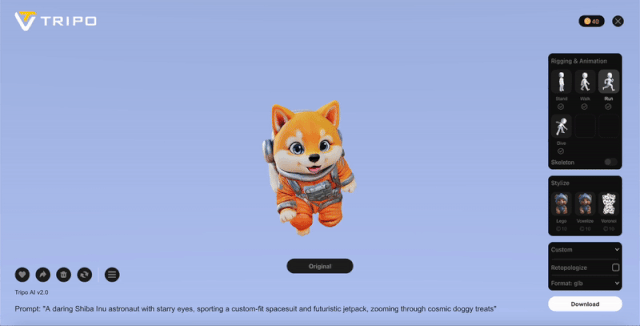3D modeling has long been a cornerstone of industries like gaming, product design, and architecture. In gaming, each release pushes the limits, demanding increasingly intricate virtual environments. For product designers, 3D models are essential to visualize concepts before they move to production. Architects, too, rely on detailed renderings to walk clients through designs before breaking ground. Yet, despite its importance, 3D modeling has traditionally been a slow, resource-intensive process.
Now, that’s starting to change with the arrival of generative artificial intelligence. While initial excitement around this technology focused on its ability to generate 2D images, some developers saw an opportunity to transform 3D content creation. In fields where 3D assets are essential, AI-driven models could streamline workflows, producing high-quality models at scale and drastically reducing both time and cost.
Take Vast, for instance. Founded in 2023, the Chinese startup is aiming to make 3D modeling more efficient and accessible. Its latest product, Tripo AI, exemplifies how generative AI is shaking up this space.
With Tripo AI, users can create detailed, textured 3D models from simple text or image prompts in seconds. The first version of the tool, Tripo 1.0, could generate a model in about eight seconds. Now, with Tripo 2.0, speed and quality have both improved, making it an even more versatile tool for professionals and hobbyists alike.
Tripo AI stands out for its multimodal input capabilities, allowing users to generate 3D models from various prompts—whether it’s a single image, multiple images, or a few lines of text.
A key feature of Tripo AI is its customization options. Users can adjust model proportions, such as head, arms, and legs, and select different starting poses. Once complete, the model can be refined further, including rigging for animation. Export options in formats like STL, OBJ, and GLB offer flexibility for different creative needs.
Tripo AI’s interface also has a unique prompt gallery. As users build prompts, they are shown a gallery of previously generated models with similar inputs, providing visual cues to refine their ideas. The platform’s “Popcorn” feature even suggests more elaborate alternatives to user-written prompts, though these use cases remain somewhat niche.
In one test, KrASIA input the prompt “Shiba Inu, astronaut, jetpack” into Tripo AI. Both the standard and “Popcorn” prompts generated intricate, geometrically accurate models with detailed textures.


Tripo AI also offers rigging tools, though results vary. While simple movements like walking were rendered smoothly, more complex animations—like running with a jetpack—showed some oddities, such as a jetpack that appeared too fluid.


To assess its image-to-3D capabilities, KrASIA reviewed Tripo AI’s rendering of a doll from an image with a simple background. The resulting 3D model closely matched the source, demonstrating the platform’s strength in handling clean, uncomplicated inputs. However, it remains to be seen how it performs with more complex images featuring intricate textures or busy backgrounds.


Vast has trained Tripo AI on a proprietary dataset of millions of 3D models. Its architecture combines a document image transformer (DiT), which excels at capturing long-range dependencies in 3D structures, with U-Net to preserve finer details. Together, these technologies enable Tripo to deliver high-quality outputs efficiently.
Vast, based in Beijing, is led by CEO Simon Song, CTO Liang Ding, and head of research Yanpei Cao. Song and Ding both previously worked at SenseTime, while Cao was a principal researcher at Tencent. Song also co-founded MiniMax, a Chinese unicorn known for its work in generative AI, including Hailuo AI.
Vast is not alone in this race. Competitors like Meshy, Deepmotion, and Alpha3D are also making strides in the field. Globally, companies like World Labs, co-founded by AI pioneer Fei-Fei Li, are pushing to develop large world models that interact with 3D environments, aiming to expand the boundaries of AI-generated content.
With 3D generative AI still in its early stages, no clear leader has yet emerged. But with companies like Vast at the forefront, this once labor-intensive process could soon become faster, cheaper, and more accessible, opening new possibilities across industries.
